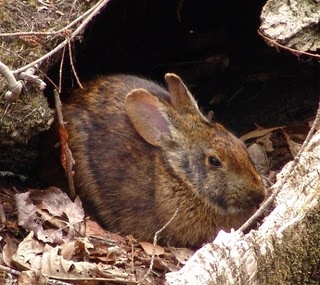Lower Keys Marsh Rabbit
Lower Keys Marsh Rabbit, also known as Sylvilagus palustris hefneri, is a species of the marsh rabbit and is named after the Playboy founder Hugh Hefner. Although the marsh rabbit is widespread all across the southern part of the U.S., the so-called Hefner’s rabbit is endangered and inhabits higher positioned areas with salt marshes or freshwater marshes, most of them are positioned in the area of Florida Keys.
The Hefner’s rabbit is small to medium sized, reaching up to 30 centimetres in length and up to 3 pounds in weight. They can be distinguished from other marsh rabbit subspecies by their darker colouration and it’s skull proportions. Lower Key Marsh rabbits have dark brown fur with a lighter underside and is typically smaller than other subspecies of the marsh rabbit.
These rabbits are solitary grass-eaters, although they may cluster in areas of high food availability. They also choose a specific diet, which is why most of them inhabit only the areas around Florida Keys. Most of the rabbit’s diet consists of marsh plants and herbs, specifically ones found in mid- and high- marsh areas, therefore they prefer living higher than other marsh rabbits.
Lower Keys Marsh Rabbits were first described in a publication by James D. Lazell Jr., with great financial help of the Playboy Corporation, resulting in the rabbit being named after Playboy’s founder Hugh Hefner. Therefore, the myth of Lower Keys Marsh Rabbit being named after Hefner due to their supposed similarity in sexual habits, is wrong.
The Lower Keys Marsh Rabbits do, however, mate very frequently. Their breeding season lasts from February till September and during this time, copulation is very often. Males are polygamous, which means they may mate with multiple females during the season. The gestation period is usually around 30 days and a single female gives birth to an average of 3.7 rabbits per year. Compared to the 5.7 rabbits that are given birth by the other subspecies, the Lower Keys Marsh Rabbits have a relatively low reproduction rate. Nursing lasts for about two weeks.
Image source: Audubon South Carolina
It’s not unusual for males to migrate to different areas during breeding season, however the females stay within their home range. They live in nests made of grass and weeds and are threatened by flooding. The male rabbits do not take part in nursing the young.
Currently, the Lower Keys Marsh Rabbit is listed as “Endagered” by the IUCN. Plans are being developed to conserve these rabbits, as their population is highly affected by pollution, loss of vegetation and demolishing of their natural habitat. Many Hefner’s Rabbits are also killed by cats or by cars. Currently, it seems that the best chance of preserving this species would be introducing them to another area that is suited for them.





a rabbit sooooooooooooooooooooooooo cute
i have biology and we are doing a project a project on the lower keys marsh rabbit! they were too cute to pass up!:)
Nice picture. I took it at the Audubon Center at Francis Beidler Forest in Four Holes Swamp, SC on March 22, 2008.
http://beidlerforest.blogspot.com/2008/03/easter-bunny.html